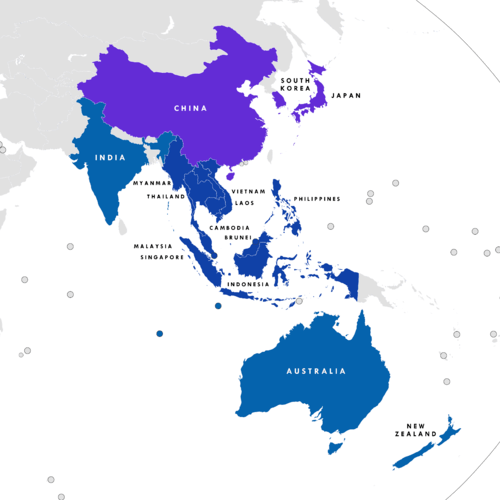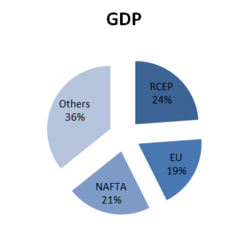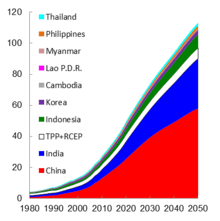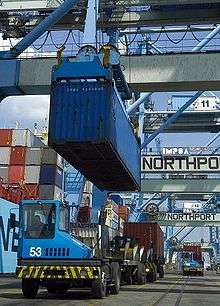Regional Comprehensive Economic Partnership
| Type | Trade agreement |
|---|---|
| Effective | Not in force |
| Original signatories |
Regional Comprehensive Economic Partnership (RCEP) is a proposed free trade agreement (FTA) between the ten member states of the Association of Southeast Asian Nations (ASEAN) (Brunei, Cambodia, Indonesia, Laos, Malaysia, Myanmar, the Philippines, Singapore, Thailand, Vietnam) and the six Asia-Pacific states with which ASEAN has existing free trade agreements (Australia, China, India, Japan, South Korea and New Zealand). It is reported that a broad agreement is likely to be reached in November 2018.[1]
RCEP negotiations were formally launched in November 2012 at the ASEAN Summit in Cambodia.[2] The free trade agreement is scheduled and expected to be signed in November 2018 during the ASEAN Summit and Related Summit in Singapore, after the first RCEP summit was held on 14 November 2017 in Manila, Philippines.[3] RCEP is viewed as an alternative to the Trans-Pacific Partnership (TPP), a proposed trade agreement which includes several Asian and American nations but excludes China and India.[4]
In 2017, prospective RCEP member states accounted for a population of 3.4 billion people with a total Gross Domestic Product (GDP, PPP) of $49.5 trillion, approximately 39 percent of the world's GDP,[5] with the combined GDPs of China and India making up more than half that amount.
RCEP is the world's largest economic bloc, covering nearly half of the global economy.[6] According to estimates by PwC, the Gross Domestic Product (GDP, PPP) of RCEP member states is likely to amount to nearly $250 trillion by 2050, or a quarter of a quadrillion dollars, with the combined GDPs of China and India making up more than 75% of the amount. RCEP's share of the global economy could account for half of the estimated $0.5 quadrillion global GDP (PPP) by 2050.
Membership

The arrangement is also open to any other external economic partners, such as nations in Central Asia and remaining nations in South Asia and Oceania.[7]
The RCEP 16 countries
- the 10 members of ASEAN
- plus the three additional members of ASEAN Plus Three
- plus the three additional members of ASEAN Plus Six
Basic indicators of the RCEP 16 countries
| Flag | Country | Capital | Area (km²) | Population | Nominal GDP (millions of US$) | GDP per cap. (Nominal, US$) | PPP GDP (millions of Int$) | GDP per cap. (PPP, Int$) | HDI | Currency | Official languages | Leaders |
|---|---|---|---|---|---|---|---|---|---|---|---|---|
| Australia Commonwealth of Australia | Canberra | 7,692,024 | 24,419,900 | 1,482,282 | 55,215 | 1,296,075 | 50,817 | 0.939 | Australian dollar ($) (AUD) | None National and de facto: English | Monarch: Elizabeth II Governor-General: Peter Cosgrove Prime Minister: Scott Morrison | |
| Brunei Nation of Brunei, the Abode of Peace Negara Brunei Darussalam | Bandar Seri Begawan | 5,765 | 417,200 | 11,991 | 28,740 | 33,756 | 76,567 | 0.865 | Brunei dollar ($) (BND) | Malay | Monarch: Hassanal Bolkiah | |
| Cambodia Kingdom of Cambodia Preăh Réachéanachâk Kâmpŭchéa | Phnom Penh | 181,035 | 15,626,444 | 24,307 | 1,308 | 69,884 | 4,022 | 0.563 | Cambodian riel (៛) (KHR) | Khmer | Monarch: Norodom Sihamoni Prime Minister: Hun Sen | |
| China People's Republic of China Zhōnghuá Rénmín Gònghéguó | Beijing | 9,596,961 | 1,382,580,000 | 13,118,689 | 9,489 | 25,102,916 | 18,158 | 0.738 | Renminbi (Chinese yuan, ¥) (CNY) | Standard Chinese written in simplified characters see also: Languages of China | Premier: Li Keqiang President: Xi Jinping | |
| India Republic of India Bhārat Gaṇarājya | New Delhi | 3,287,263 | 1,314,470,000 | 2,654,165 | 1,850 | 10,339,552 | 7,153 | 0.624 | Indian rupee (₹) (INR) | Hindi
English |
President: Ram Nath Kovind Prime Minister: Narendra Modi | |
| Indonesia Republic of Indonesia Republik Indonesia | Jakarta | 1,910,931 | 263,510,000 | 1,092,138 | 3,895 | 3,481,107 | 12,432 | 0.689 | Indonesian rupiah (Rp) (IDR) | Indonesian see also: Languages of Indonesia | President: Joko Widodo | |
| Japan Nippon-koku | Tokyo | 377,930 | 126,760,000 | 5,063,129 | 38,281 | 5,545,884 | 42,860 | 0.903 | Japanese yen (¥) (JPY) | Japanese | Monarch: Akihito Prime Minister: Shinzō Abe | |
| Laos Lao People's Democratic Republic Sathalanalat Paxathipatai Paxaxon Lao | Vientiane | 236,800 | 6,492,400 | 18,674 | 2,051 | 53,626 | 6,115 | 0.586 | Lao kip (₭) (LAK) | Lao | Prime Minister: Thongloun Sisoulith President: Bounnhang Vorachith | |
| Malaysia | Kuala Lumpur Putrajaya (administrative) | 330,803 | 32,019,500 | 340,923 | 9,623 | 988,993 | 28,636 | 0.789 | Malaysian ringgit (RM) (MYR) | Malaysian see also: Languages of Malaysia | Monarch: Muhammad V Prime Minister: Tun Dr. Mahathir bin Mohamad | |
| Myanmar (Burma) Republic of the Union of Myanmar Pyidaunzu Thanmăda Myăma Nainngandaw | Naypyidaw | 676,578 | 54,836,000 | 74,002 | 1,374 | 362,969 | 6,360 | 0.556 | Burmese kyat (K) (MMK) | Burmese see also: Languages of Myanmar | President: Htin Kyaw State Counsellor: Aung San Suu Kyi | |
| New Zealand Aotearoa | Wellington | 270,467 | 4,786,710 | 215,172 | 41,107 | 195,103 | 38,706 | 0.915 | New Zealand dollar ($) (NZD) | English Māori | Monarch: Elizabeth II Governor-General: Patsy Reddy Prime Minister: Bill English | |
| Philippines Republic of the Philippines Republika ng Pilipinas | Manila | 300,000 | 103,874,000 | 357,792 | 3,102 | 951,224 | 8,270 | 0.682 | Philippine peso (₱) (PHP) | Filipino (Tagalog) English | President: Rodrigo Duterte | |
| Singapore Republic of Singapore Republik Singapura Xīnjiāpō Gònghéguó Ciṅkappūr Kuṭiyaracu | Singapore (city-state) | 719 | 5,607,300 | 316,872 | 51,431 | 537,447 | 90,724 | 0.925 | Singapore dollar ($) (SGD) | Malay English Mandarin Tamil see also: Languages of Singapore | President: Halimah Yacob Prime Minister: Lee Hsien Loong | |
| South Korea Republic of Korea Daehan Minguk | Seoul | 100,210 | 51,446,201 | 1,597,392 | 29,114 | 2,127,164 | 39,446 | 0.901 | South Korean won (₩) (KRW) | Korean | Prime Minister: Lee Nak-yeon President: Moon Jae-in | |
| Thailand Kingdom of Thailand Ratcha-anachak Thai | Bangkok | 513,120 | 68,298,000 | 466,623 | 6,265 | 1,296,095 | 17,749 | 0.740 | Thai baht (฿) (THB) | Thai | Monarch: Vajiralongkorn Prime Minister: Prayut Chan-o-cha | |
| Vietnam Socialist Republic of Vietnam Cộng hòa Xã hội chủ nghĩa Việt Nam | Hanoi | 331,212 | 92,700,000 | 234,688 | 2,305 | 697,752 | 6,925 | 0.683 | Vietnamese đồng (₫) (VND) | Vietnamese | Prime Minister: Nguyễn Xuân Phúc President: Trần Đại Quang |
Presence in the world


RCEP potentially includes more than 3 billion people or 45% of the world's population, and a combined GDP of about $21.3 trillion, accounting for about 40 percent of world trade.[9] The combined GDP of potential RCEP members surpassed the combined GDP of Trans-Pacific Partnership (TPP) members in 2007. Continued growth, particularly in China, India and Indonesia could see total GDP in RCEP grow to over $100 trillion by 2050, roughly double the project size of TPP economies.[10]
The resulting impact of the RCEP will take significant strides towards bridging the economic divide between developed and less-developed members of this region. In large, this will be due to the growth of global production networks and supply chains in East Asia, and the streamlining of silo FTAs in ASEAN.[11]

On January 23, 2017, United States President Donald Trump signed a memorandum that stated withdrawal of the country from the TPP, a move which is seen to improve the chances of success for RCEP.[12]
History and timeline
- During the 19th ASEAN Summit held 14–19 November 2011, the Regional Comprehensive Economic Partnership (RCEP) was introduced.[13]
- The 44th ASEAN Economic Ministers (AEM) Meeting and Related Meetings were held in Siem Reap, Cambodia, 25 August - 1 September 2012.[14]
- Leaders at the 21st ASEAN Summit held 18–20 November 2012 in Phnom Penh, Cambodia endorsed the framework of RCEP and announced the launch of their negotiations.[15]
- Round 1: 9–13 May 2013 in Brunei[8]
- The second round of RCEP negotiations were held 23–27 September 2013 in Brisbane, Australia.[16]
- The third round of the Regional Comprehensive Economic Partnership (RCEP) Negotiations were held 20–24 January 2014 in Kuala Lumpur, Malaysia.[17]
- The 4th round of RCEP negotiations took place in Nanning, China 31 March – 4 April 2014.[18]
- The 5th RCEP negotiation round was held on 21–27 June 2014 in Singapore.[19]
- The 6th round of RCEP Trade Negotiation Committee(TNC) and related meetings took place 1–5 December 2014 in New Delhi, India.[20] The Indians held an outreach event with their business community to educate them on the goals of RCEP. The Japanese asked to set up a workshop on e-Commerce.
- The 7th round of RCEP meetings took place in Bangkok, Thailand 9–13 February 2015. An expert group on electronic commerce met during this round. The Asian Trade Centre (based in Singapore) submitted a proposal regarding an e-Commerce chapter and gave a presentation on the paper.
- The 8th round of the RCEP talks took place in Kyoto, Japan 5–13 June.
- The 9th round of the RCEP talks took place in Nay Pyi Taw, Myanmar 3–7 August 2015.
- The 10th round of the RCEP talks took place in Busan, South Korea in 12–16 October 2015. The meetings took place at BEXCO (Busan's Convention and Exhibition Centre). This round included the first region wide stakeholder meeting (organized by the Singapore-based Asian Trade Centre) which involved an informal meeting between government officials and business representatives over lunch followed by an afternoon seminar focused on what RCEP can do to help business operate in the e-Commerce space.
- On February 14–19, the 11th round of negotiations of the RCEP was held in Bandar Seri Begawan, Brunei.[21]
- On April 17–29, the 12th round of negotiation of RCEP was held in Perth, Australia. [22]
- Round 13: June 2016 in New Zealand
- The 14th round of RCEP negotiation was held on August 15–18 in Vietnam.
- The 15th round of RCEP negotiation was held on October 11–22 in Tianjin, China.[23]
- The 16th round of negotiations of RCEP was held on December 6–10 in Tangerang, Indonesia.
- The 17th round of negotiations of RCEP was held in Kobe, from February 27 to March 3 in Kobe, Japan.
- The 18th round of RCEP negotiation was held on May 8–12 in Manila, Philippines.[24]
- The 19th round of RCEP negotiation was held on July 24–28 in Hyderabad, India.[25]
- Round 20: September 2017 in Philippines
- Round 21: The first RCEP summit was held on Nov 14 in Manila, Philippines.[6][26]
- Round 22: March 2018 in Singapore
- Aug 31: The two day meeting in Singapore ended with all RCEP members agreeing to put forward proposals by Oct 10 regarding ease of movement for workers. Member countries went on to agree to the establishment of an investor-state dispute settlement (ISDS) mechanism.[27] India wins important concessions with RCEP members allowing India over 20 years to remove tariffs on key items from China, Australia and New Zealand.[28]
- August-October 2018, a series of ministerial meeting in Singapore and Auckland.[29]
- November 2018, Leaders' summit in Singapore where a broad agreement is expected.[30]
Controversies and criticism
RCEP has been criticized by free culture activists for containing "quite simply the worst provisions on copyright [...] ever seen in a trade agreement."[31] Global health care activists have criticized the agreement for potentially forcing India to end its cheap supply of generic medications to poor countries.[32]
See also
- Comprehensive Economic Partnership for East Asia (CEPEA)
- Comprehensive and Progressive Agreement for Trans-Pacific Partnership (CPTPP)
- East Asian Community
- East Asia Summit
- South Asian Free Trade Area
- ASEAN+3
- Free trade agreement
- Free Trade Area of the Asia-Pacific (FTAAP)
- Trans-Pacific Partnership (TPP)
References
- ↑ South China Morning Post (Sep 3, 2018). "US trade war and Japan push raise prospects for China-backed Asia free-trade deal".
- ↑ "RCEP: Challenges and Opportunities for India, 25 July 2013, RSIS, Singapore" (PDF). rsis.edu.sg.
- ↑ "RCEP likely to be signed in November 2018: PM". www.thesundaily.my.
- ↑ Tang, See Kit (14 October 2015). "RCEP: The next trade deal you need to know about". cnbc.com.
- ↑ Stefani Ribka/Linda Yulisman (December 7, 2016). "RCEP talks speed up amid TPP failure".
- 1 2 "Najib: RCEP likely to be signed in Nov 2018". 15 November 2017.
- ↑ What is the Regional Comprehensive Economic Partnership (RCEP)? Ministry of Trade and Industry Singapore November 2012
- 1 2 {{cite web|url=http://www.asean.org/news/asean-statement-communiques/item/regional-comprehensive-economic-partnership-rcep-joint-statement-the-first-meeting-of-trade-negotiating-committee%7Ctitle= Regional Comprehensive Economic Partnership (RCEP) Joint Statement The First Meeting of Trade Negotiating Committee|darte=10 May 2013|archiveurl=https://web.archive.org/web/20150219224756/http://www.asean.org/news/asean-statement-communiques/item/regional-comprehensive-economic-partnership-rcep-joint-statement-the-first-meeting-of-trade-negotiating-committee%7Carchivedate=February 19, 2015
- ↑ Diplomat, Rohit Sinha and Geethanjali Nataraj, The. "Regional Comprehensive Economic Partnership (RCEP): Issues and Way Forward". thediplomat.com.
- 1 2 "Understanding and applying long-term GDP projections | EABER". www.eaber.org. Retrieved 2016-06-17.
- ↑ "RCEP Negotiations Reach Critical Stage – Likely to be Inked by Year-End". aseanbriefing.com. 7 September 2018.
- ↑ Reichert, Corinne. "Trump dumping Trans-Pacific Partnership - ZDNet". zdnet.com.
- ↑ Nineteenth ASEAN Summit, Bali, Indonesia | 14-19 November 2011 Archived 29 June 2013 at the Wayback Machine.
- ↑ "ASEAN plus 6 agree to start RCEP talks CCTV News - CNTV English". english.cntv.cn.
- ↑ Announcement of the Launch of Negotiations for the Regional Comprehensive Economic Partnership (RCEP) Ministry of Economy, Trade and Industry Japan 20 November 2012 Archived 14 October 2013 at the Wayback Machine.
- ↑ Australia hosts second round of Regional Comprehensive Economic Partnership (RCEP) Negotiations in Brisbane Archived 3 October 2013 at the Wayback Machine.
- ↑ Media Release : 3rd Meeting of the RCEP Trade Negotiation Committee 20-24 January 2014, Kuala Lumpur, Malaysia | 27 Jan 2014 08:40 AM | The Ministry of International Trade and Industry, Malaysia Archived 22 February 2014 at the Wayback Machine.
- ↑ "Fourth Round of Negotiations for Regional Comprehensive Economic Partnership (RCEP)". Joint press release of Japanese Ministry of Economy, Trade, and Industry with the Ministry of Foreign Affairs. 2014-04-04.
- ↑ "5th negotiation of Regional Comprehensive Economic Partnership Agreement (RCEP)". Ministry of Industry and Trade of the Socialist Republic of Vietnam. 30 June 2014. Retrieved 20 December 2015.
- ↑ "Department of commerce". commerce.nic.in.
- ↑ http://fta.mofcom.gov.cn/enarticle/rcepen/enrcepnews/201603/30820_1.html
- ↑ http://english.mofcom.gov.cn/article/newsrelease/significantnews/201605/20160501312566.shtml
- ↑ "The 14th Round of Negotiation of Regional Comprehensive Economic Partnership Held in Ho Chi Minh City, Vietnam -". english.mofcom.gov.cn.
- ↑ http://www.dti.gov.ph/media/latest-news/10511-asean-fta-partners-meet-for-rcep-in-manila
- ↑ S, Arun (27 July 2017). "India pressed to open up procurement". The Hindu.
- ↑ "Now push RCEP, Abe-san". The Straits Times. 24 November 2017.
- ↑ "The RCEP Trade Deal and Why its Success Matters to China". China Briefing. Sep 6, 2018.
- ↑ "RCEP Members Agree to Liberalize Services Market, Other Concessions for India". india-briefing.com. 5 Sep 2018.
- ↑ Livemint (Sep 5, 2018). "India wins key concession on services at RCEP Singapore Ministerial".
- ↑ South China Morning Post (Sep 3, 2018). "US trade war and Japan push raise prospects for China-backed Asia free-trade deal".
- ↑ "RCEP: The Other Closed-Door Agreement to Compromise Users' Rights". Electronic Frontier Foundation. 2016-04-20. Retrieved 2016-04-28.
- ↑ Chandran, Nyshka (2017-01-12). "China-backed trade deal may not gain from TPP's loss. Blame India". CNBC.
